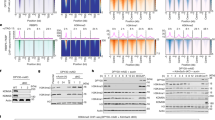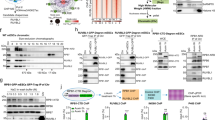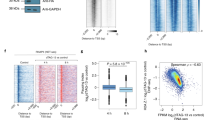Abstract
Promoter-proximal pausing of RNA polymerase II (Pol II) is a major checkpoint in transcription. An unbiased search for new human proteins that could regulate paused Pol II at the HSPA1B gene identified TRIM28. In vitro analyses indicated HSF1-dependent attenuation of Pol II pausing upon TRIM28 depletion, whereas in vivo data revealed de novo expression of HSPA1B and other known genes regulated by paused Pol II upon TRIM28 knockdown. These results were supported by genome-wide ChIP-sequencing analyses of Pol II occupancy that revealed a global role for TRIM28 in regulating Pol II pausing and pause release. Furthermore, in vivo and in vitro mechanistic studies suggest that transcription-coupled phosphorylation regulates Pol II pause release by TRIM28. Collectively, our findings identify TRIM28 as a new factor that modulates Pol II pausing and transcriptional elongation at a large number of mammalian genes.
This is a preview of subscription content, access via your institution
Access options
Subscribe to this journal
Receive 12 print issues and online access
$189.00 per year
only $15.75 per issue
Buy this article
- Purchase on Springer Link
- Instant access to full article PDF
Prices may be subject to local taxes which are calculated during checkout





Similar content being viewed by others
Accession codes
References
Rahl, P.B. et al. c-Myc regulates transcriptional pause release. Cell 141, 432–445 (2010).
Rasmussen, E.B. & Lis, J.T. In vivo transcriptional pausing and cap formation on three Drosophila heat shock genes. Proc. Natl. Acad. Sci. USA 90, 7923–7927 (1993).
Nechaev, S. et al. Global analysis of short RNAs reveals widespread promoter-proximal stalling and arrest of Pol II in Drosophila. Science 327, 335–338 (2010).
Muse, G.W. et al. RNA polymerase is poised for activation across the genome. Nat. Genet. 39, 1507–1511 (2007).
Core, L.J., Waterfall, J.J. & Lis, J.T. Nascent RNA sequencing reveals widespread pausing and divergent initiation at human promoters. Science 322, 1845–1848 (2008).
Zeitlinger, J. et al. Whole-genome ChIP-chip analysis of Dorsal, Twist, and Snail suggests integration of diverse patterning processes in the Drosophila embryo. Genes Dev. 21, 385–390 (2007).
Seila, A.C. et al. Divergent transcription from active promoters. Science 322, 1849–1851 (2008).
Adelman, K. & Lis, J.T. Promoter-proximal pausing of RNA polymerase II: emerging roles in metazoans. Nat. Rev. Genet. 13, 720–731 (2012).
Gaertner, B. et al. Poised RNA polymerase II changes over developmental time and prepares genes for future expression. Cell Reports 2, 1670–1683 (2012).
Wu, C.H. et al. NELF and DSIF cause promoter proximal pausing on the hsp70 promoter in Drosophila. Genes Dev. 17, 1402–1414 (2003).
Peterlin, B.M. & Price, D.H. Controlling the elongation phase of transcription with P-TEFb. Mol. Cell 23, 297–305 (2006).
Gilchrist, D.A. et al. NELF-mediated stalling of Pol II can enhance gene expression by blocking promoter-proximal nucleosome assembly. Genes Dev. 22, 1921–1933 (2008).
Rabindran, S.K., Giorgi, G., Clos, J. & Wu, C. Molecular cloning and expression of a human heat shock factor, HSF1. Proc. Natl. Acad. Sci. USA 88, 6906–6910 (1991).
Sun, J. & Li, R. Human negative elongation factor activates transcription and regulates alternative transcription initiation. J. Biol. Chem. 285, 6443–6452 (2010).
Cheng, B. et al. Functional association of Gdown1 with RNA polymerase II poised on human genes. Mol. Cell 45, 38–50 (2012).
Byun, J.S. et al. ELL facilitates RNA polymerase II pause site entry and release. Nat. Commun. 3, 633 (2012).
Ulrich, H. DNA and RNA aptamers as modulators of protein function. Med. Chem. 1, 199–208 (2005).
Hendrix, D.A., Hong, J.W., Zeitlinger, J., Rokhsar, D.S. & Levine, M.S. Promoter elements associated with RNA Pol II stalling in the Drosophila embryo. Proc. Natl. Acad. Sci. USA 105, 7762–7767 (2008).
Lee, C. et al. NELF and GAGA factor are linked to promoter-proximal pausing at many genes in Drosophila. Mol. Cell. Biol. 28, 3290–3300 (2008).
Iyengar, S., Ivanov, A.V., Jin, V.X., Rauscher, F.J. III & Farnham, P.J. Functional analysis of KAP1 genomic recruitment. Mol. Cell. Biol. 31, 1833–1847 (2011).
Chen, L. et al. Tripartite motif containing 28 (Trim28) can regulate cell proliferation by bridging HDAC1/E2F interactions. J. Biol. Chem. 287, 40106–40118 (2012).
Messerschmidt, D.M. et al. Trim28 is required for epigenetic stability during mouse oocyte to embryo transition. Science 335, 1499–1502 (2012).
Hu, G. et al. A genome-wide RNAi screen identifies a new transcriptional module required for self-renewal. Genes Dev. 23, 837–848 (2009).
Chikuma, S., Suita, N., Okazaki, I.M., Shibayama, S. & Honjo, T. TRIM28 prevents autoinflammatory T cell development in vivo. Nat. Immunol. 13, 596–603 (2012).
Vassylyev, D.G. et al. Structural basis for substrate loading in bacterial RNA polymerase. Nature 448, 163–168 (2007).
Kininis, M., Isaacs, G.D., Core, L.J., Hah, N. & Kraus, W.L. Postrecruitment regulation of RNA polymerase II directs rapid signaling responses at the promoters of estrogen target genes. Mol. Cell. Biol. 29, 1123–1133 (2009).
Zobeck, K.L., Buckley, M.S., Zipfel, W.R. & Lis, J.T. Recruitment timing and dynamics of transcription factors at the Hsp70 loci in living cells. Mol. Cell 40, 965–975 (2010).
Gilchrist, D.A. et al. Regulating the regulators: the pervasive effects of Pol II pausing on stimulus-responsive gene networks. Genes Dev. 26, 933–944 (2012).
Makalowski, W. & Boguski, M.S. Evolutionary parameters of the transcribed mammalian genome: an analysis of 2,820 orthologous rodent and human sequences. Proc. Natl. Acad. Sci. USA 95, 9407–9412 (1998).
Ziv, Y. et al. Chromatin relaxation in response to DNA double-strand breaks is modulated by a novel ATM- and KAP-1 dependent pathway. Nat. Cell Biol. 8, 870–876 (2006).
White, D. et al. The ATM substrate KAP1 controls DNA repair in heterochromatin: regulation by HP1 proteins and serine 473/824 phosphorylation. Mol. Cancer Res. 10, 401–414 (2012).
Lee, D.H. et al. Phosphoproteomic analysis reveals that PP4 dephosphorylates KAP-1 impacting the DNA damage response. EMBO J. 31, 2403–2415 (2012).
Li, X. et al. Role for KAP1 serine 824 phosphorylation and sumoylation/desumoylation switch in regulating KAP1-mediated transcriptional repression. J. Biol. Chem. 282, 36177–36189 (2007).
Chen, B.P. et al. Ataxia telangiectasia mutated (ATM) is essential for DNA-PKcs phosphorylations at the Thr-2609 cluster upon DNA double strand break. J. Biol. Chem. 282, 6582–6587 (2007).
Yoon, Y.J. et al. KRIBB11 inhibits HSP70 synthesis through inhibition of heat shock factor 1 function by impairing the recruitment of positive transcription elongation factor b to the hsp70 promoter. J. Biol. Chem. 286, 1737–1747 (2011).
Wolf, D. & Goff, S.P. TRIM28 mediates primer binding site-targeted silencing of murine leukemia virus in embryonic cells. Cell 131, 46–57 (2007).
Ivanov, A.V. et al. PHD domain-mediated E3 ligase activity directs intramolecular sumoylation of an adjacent bromodomain required for gene silencing. Mol. Cell 28, 823–837 (2007).
Lee, W. et al. A high-resolution atlas of nucleosome occupancy in yeast. Nat. Genet. 39, 1235–1244 (2007).
Herquel, B. et al. Transcription cofactors TRIM24, TRIM28, and TRIM33 associate to form regulatory complexes that suppress murine hepatocellular carcinoma. Proc. Natl. Acad. Sci. USA 108, 8212–8217 (2011).
Acknowledgements
We appreciate S. Elledge at the Harvard Medical School for mediating collaborations and R. Young and D. Orlando at Massachusetts Institute of Technology (MIT) for providing with helpful comments and perspectives for the manuscript. We thank A. York, A. Schubert, M. Knuesel, T. Westerling and J. Stinchfield for technical support and thank C. Wu (US National Cancer Institute (NCI)) for the HSF1 vector, R. Kelm Jr. (University of Vermont) for the PURb antibody and F. Zhu (Florida State University) for the GST-TRIM28 vectors. We thank the laboratories of S. Alper, M. Pollak and M. Brown at Beth Israel Deaconess Medical Center (BIDMC) for technical assistance, equipment and discussions. H.B. thanks M. Cross and M.A. Stevenson at BIDMC for administrative support and J. Park and D. Bunch for loving encouragement throughout the work. This study was supported by grants from the US National Institutes of Health (NIH) (RO-1CA047407) and the Harvard Joint Center for Radiation Therapy to S.K.C. and H.B., from the Koch Institute for Integrative Cancer Research at MIT (P30-CA14051) and the MIT Center for Environmental Health Sciences (P30-ES002109) to S.M. and S.L. and also from the NCI (R01CA127364) and the American Cancer Society (RSG 0927401DMC) to D.J.T. This research was supported in part by the Intramural Research Program of the NIH NIEHS (1ZIAES102745-02) to G.H. and X.Z. and to A.B. and D.F.
Author information
Authors and Affiliations
Contributions
X.Z. and G.H. generated WT and TRIM28 KD mES-cell extracts for ChIP-seq and ChIP-qPCR. S.M. and S.L. processed ChIP-seq. A.B., G.H. and D.F. performed bioinformatics. S.T.D. and C.C.E. carried out MS. G.B. constructed TRIM28 plasmids. H.B., D.J.T. and S.K.C. designed the experiments and wrote the manuscript. D.J.T. and G.H. contributed equally to the analyses as jointly supervising authors.
Corresponding author
Ethics declarations
Competing interests
The authors declare no competing financial interests.
Integrated supplementary information
Supplementary Figure 1 Oligonucleotide pulldown assay.
(a) Predicted secondary structures of HSPA1B and GREB1 non-template DNA oligos used in the pull-down assay. G-C richness of HSPA1B transcriptional start site results in unique hairpin structures from different sizes of the non-template DNA. On the other hand, GREB1, a non-pausing control gene, lacks the hairpin structure. N.T stands for the Non-Template DNA. These structures were obtained using oligo structure prediction software from Integrated DNA technologies. (b) Oligo pull-down assays. Immobilized non-template ssDNA segments of HSPA1B +1 to +80 and GREB1 +1 to +50 were incubated with HeLa nuclear extracts and subjected to different wash conditions, 0.1, 0.3, 0.5, and 1 M HEMG, in order to optimize the sample preparation. We chose the wash condition with 0.5 M HEMG for mass spectrometry and immunoblotting to identify proteins bound near the pausing site of HSPA1B. SM, Size Marker; c, GREB1 as a non-pausing control (Kininis, M. et al. Mol. Cell. Biol. 29, 1123-1133); h80, HSPA1B +1 to +80.
Supplementary Figure 2 Proteins, DNA and TRIM28-depleted NE prepared for this study.
(a) DNA template and purified proteins used in this study. a. TATA box binding mutant of HSPA1B (-467 and +216), gel purified. (b) 5′ end biotinylated WT HSPA1B (-467 to +216), gel-purified. (c) Silver stained gel of purified GST-tagged full-length (left) and truncated (right) TRIM28. d. Left, his6-tagged HSF1 stained with Coomassie Blue reagent (Biorad). Right, untagged HSF1, silver-stained and confirmed with western blot. e. TRIM28 immunodepletion from HeLa nuclear extracts. Bound proteins were eluted and separated on the SDS-PAGE gel, followed by silver-staining. SM, Size Marker; Lane 1, Proteins immunoprecipitated from the first round of Immunoprecipitation (3 hours); Lane 2, Proteins immunoprecipitated from the second round of Immunoprecipitation (16 hours); Lane 3, Proteins immunoprecipitated from the third round of Immunoprecipitation (2.5 hours). TRIM28 is effectively depleted as shown with an arrow just above 100 KDa of SM.
Supplementary Figure 3 Box plots and chromosome viewers comparing WT and TRIM28-KD mESCs.
(a) and (b) Change in Gene Body Pol II of TRIM28-bound and –unbound genes. Change in normalized, input-adjusted total PolII ChIP-seq gene body reads per kilobase on TRIM28 KD as a function of TRIM28 binding. Values are plotted for genes intersecting (a) and not intersecting CpG islands (b) (p-values derived from Wilcoxon Rank Sum test). (c) UCSC Browser views of paused genes in replicates. Chromosome views of EGR1 (c), JUN (d), and ERK1 (e) with normalized and input-adjusted Total PolII ChIP-seq read counts in WT and TRIM28 KD mES cells.
Supplementary Figure 4 Pausing-index changes in replicates.
(a) Scatter plots depict per-replicate TRIMKD vs. WT pausing index fold change on log2 scale, as a function of WT pausing index (N= 8,652 (Rep #1), 8655 (Rep#2)). Plots do not include genes with undefined pausing index resulting from zero promoter or gene body read density in either condition. (b) Zoom-In views of plots shown in a, between 0 and 300 in pausing index in WT. (c) Scatter plots of raw pausing indices of replicate 1 versus replicate 2 for WT and TRIM28 KD. Plots were generated combining the genes with RPKM greater than 1, for all samples in both the promoter and gene body window (N=601). (d) Summary of paused genes regulated by TRIM28. Paused genes are defined using the following criteria: gene body and promoter windows >=50% mappable and p-value <= 0.001 (poisson probability of observing X or greater promoter density given expected value equal to gene body density). Paused genes have pausing index equal or greater than 5.
Supplementary Figure 5 Individual heat maps with raw Pol II and S2 Pol II ChIP-seq signals and inputs in replicates.
(a) Replicate 1. (b) Replicate 2.
Supplementary Figure 6 UCSC Browser views of Ier5 and the DQ072391 locus, and UCSC browser views of normalized read coverage.
(a) input for IER5 (Immediate Early Response 5). (b) input at DQ072391 (c) total Pol II at DQ072391, illustrating facilitated Pol II entry downstream of the promoter-proximal pausing site in TRIM28 KD. TSS and orientation of IER5 and DQ072391 are marked with arrowheads and the regions with noticeable increase in Pol II occupancy in KD are embraced in a red box.
Supplementary Figure 7 Purified TRIM28 WT and S824 mutants and MS analysis to identify TRIM28-interacting kinases.
(a) Dot blots showing WT and TRIM28 KD mES cells in replicates and purified WT and S824 mutant TRIM28 proteins. WT, control mES cells; KD, TRIM28 KD mES cells. (b) TRIM28 interacting proteins with mild affinity. Proteins that interact with TRIM28 were immunoprecipitated (IP) and bound proteins were eluted and visualized on a 10% acrylamide gel stained with silver. Lane 1, Size marker; lane 2, 3 hours of IP; lane 3, 2 hours of IP; lane 4, overnight IP (lane 2-4, 8% of elution was loaded on the gel); lane 5, 3 hours of IP; lane 6, 2 hours of IP; lane 7, overnight IP (lane 5-7, 34% of elution was loaded on the gel); lane 8, beads after 3 hours IP and elution; lane 9, beads after 2 hours IP and elution; lane 10, beads after overnight IP and elution. Through this experiment, the sample shown in lane 5 was subjected to MS after TCA precipitation and in-gel digestion as described in methods. (c) Untagged TRIM28 WT, S824A, and S824D proteins purified and used for transcription assays. Purified proteins were run on a gel and stained with Coomassie Blue reagent (Biorad). SM, Size marker (from the top: 250, 150, 100, 75, 50, 37, 25, and 20 KDa). Trim28 is marked by asterisk.
Supplementary Figure 8 In vitro transcription assay to characterize WT and S824-mutant TRIM28 proteins.
(a) TRIM28 WT, S824A, and S824D proteins were added with WT or TRIM28ΔNE in the transcription assay. Untagged WT, S824A, and S824D TRIM28 were supplied to WT or TRIM28ΔNE (0, 100 ng, and 600 ng). HSF1 was introduced after PIC assembly, immediately before adding NTPs. Transcription was allowed to proceed for 30 mins. The paused transcripts were visualized on a 12% sequencing gel. (b) The function and efficiency of TRIM28 WT, S824A, and S824D proteins to stabilize Pol II pausing in vitro. Approximately 100 ng of WT, S824A, and S824D were supplied to WT or TRIM28ΔNE during the PIC assembly on the HSPA1B template. After PIC was formed, loosely bound proteins were washed off (see Methods). HSF1 was included immediately before NTP addition. Transcription reaction was allowed for 45 minutes before visualizing nascent RNA transcripts on a 12% sequencing gel.
Supplementary information
Supplementary Text and Figures
Supplementary Figures 1–8, Supplementary Table 1 and Supplementary Note (PDF 3004 kb)
Supplementary Data Set 1
TRIM28-interacting proteins 1 (MS) (XLS 82 kb)
Supplementary Data Set 2
TRIM28-interacting proteins 2 (MS) (XLS 107 kb)
Supplementary Data Set 3
TRIM28-interacting proteins with mild affinity (MS) (XLS 380 kb)
Supplementary Data Set 4
Uncropped gels and images to supplement main figures (PDF 15188 kb)
Rights and permissions
About this article
Cite this article
Bunch, H., Zheng, X., Burkholder, A. et al. TRIM28 regulates RNA polymerase II promoter-proximal pausing and pause release. Nat Struct Mol Biol 21, 876–883 (2014). https://doi.org/10.1038/nsmb.2878
Received:
Accepted:
Published:
Issue Date:
DOI: https://doi.org/10.1038/nsmb.2878
This article is cited by
-
ERK2-topoisomerase II regulatory axis is important for gene activation in immediate early genes
Nature Communications (2023)
-
Trim28 citrullination maintains mouse embryonic stem cell pluripotency via regulating Nanog and Klf4 transcription
Science China Life Sciences (2023)
-
KAP1 modulates osteogenic differentiation via the ERK/Runx2 cascade in vascular smooth muscle cells
Molecular Biology Reports (2023)
-
HIF-1 Interacts with TRIM28 and DNA-PK to release paused RNA polymerase II and activate target gene transcription in response to hypoxia
Nature Communications (2022)
-
HSF1 phosphorylation establishes an active chromatin state via the TRRAP–TIP60 complex and promotes tumorigenesis
Nature Communications (2022)



